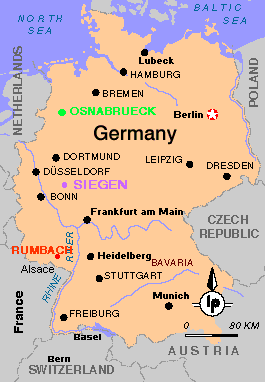
with Maps
The reasons that people emigrated from Germany to the U.S. were many.
Included are:
- Economic hardship: famine & crop failures
- Cheap farmland: the opportunity to own land was limited in Germany;
farmland was cheap in the U.S.
- Political conditions: small states, no unification, absolute rulers,
and constant wars
- Freedom from compulsory military service (esp. Prussian army)
- Religious freedom
When did Germans emigrate to the U.S.? Here is a brief timeline:
- The first group of German emigrants were Mennonites from Krefeld,
Germany. They came in 1683 to Philadelphia.
- The second group were from the Palatinate, & mid-upper Rhine areas.
They arrived 1709-1711. Some went to NY; others, like my Rector
family from Siegen on the middle Rhine, went to Virginia to work in
the iron mines. Some of my Schaub lines also emigrated in the 1730's
to Pennsylvania.
- German emigration began to increase after 1818. Included here are my
family groups from Rumbach, Germany who came in 1833---the Schaub's ,
Stoehr's & Jaggi's.
- The first BIG wave of German emigration occured from 1846-1858.
This was due mostly to famine and crop failures in 1846-47. In the Osnabrueck
area, the crop failures especially affected the flax crops, thus collapsing
the price of linen throughout the 1840's. Frederick Delbrugge left
his fathers farm in Atter, Osnabrueck in 1846, most likely for the
above reasons.
- The second BIG wave came just after the Civil War, and the Homestead
Act of 1862. Land was very cheap, and available in the U.S.
- The third BIG wave was between 1879-1890's. Most of the emigrants
in this group came from East & West Prussia, Pomerania, Posen, and
Russian Poland. My Helft and Schwartz families
were in this emigrant group, as Benjamin Schwartz came in 1879,
(possibly from Berlin) followed by the Helft family in 1880's-1890's.
Westward Migration in the United States
Many of the Germans who emigrated to the United States during colonial
times settled in Pennsylvania, and became what is known as "Pennsylvania
Dutch". Some also went to New York, Virginia, Georgia, Texas, Louisiana,
and the Carolinas. During the 1800's, people began to move westward, in
search of more and cheaper land. For the Germans, the mid-west became an
attractive area as its climate was the most familiar. (Many Germans and Swiss
who had settled in the South found conditions much too hot, as most of the
U.S. lies way south of Germany.) Thus, the "German belt" stretched from
Ohio to Nebraska, and Missouri to Wisconsin. The cities of Cincinnati,
St. Louis, Indianapolis, and Milwaukee have always had large percentages
of German-Americans. Germans also settled in many rural areas of Ohio,
Indiana, Iowa, Kansas, Missouri, the Dakotas and Wisconsin.
See the following books for more information on German emigration and migration:
- Across the Atlantic and Beyond: The Migration of German & Swiss
Emigrants to America, by Charles R. Haller. Heritage Books, 1993
- Atlas for Germanic Genealogy, by Ernest Thode; Marietta, Ohio, 1983
- Das Ohiotal, Ohio Valley: The German Dimension, by Heinrich Tolzman;
Lang, 1993
- Emigration and Settlement Patterns of German Communities in
North America; edited by Eberhard Reichmann & LaVern J. Rippley.
Indiana University, 1995
- Germanic Genealogy: A Guide to Worldwide Sources and Migration
Patterns; by Edward R. Brandt et. al. Germanic Genealogy Society, 1997
- News from the Land of Freedom: German Emigrants Write Home; by
Walter D. Kamphoefner et. al. Cornell University Press, 1991



Back to Home Page





